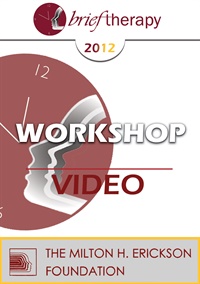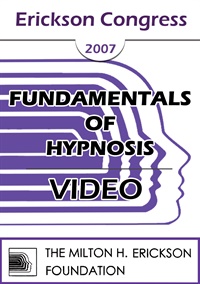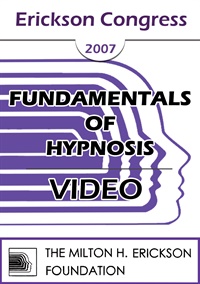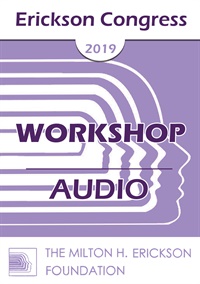
- Average Rating:
- Not yet rated
- Topic Areas:
- Workshops | Obsessive Compulsive Disorder (OCD) | Hypnosis | Post-Hypnotic Suggestion | Suggestion
- Categories:
- Erickson Congress | Erickson Congress 2019
- Faculty:
- Krzysztof Klajs, Dipl. Psych
- Duration:
- 1 Hour 57 Minutes
- Format:
- Audio Only
- Original Program Date:
- Dec 15, 2019
- Short Description:
- OCD is a rather chronic illness affecting about 2.5% of adults. Its diagnosis is perceived as a demanding and challenging one. Trance phenomena can be described as natural behavioral manifestations of the trance state. They can be observed in individuals as well as in family communication patterns. In OCD families, one of the most powerful and widely present trance phenomena are the posthypnotic suggestions. They are invisible, deeply hidden, mighty and long lasting.
- Price:
- $15.00 - Base Price
Credit available - Click Here for more information
- Average Rating:
- Not yet rated
- Topic Areas:
- Clinical Demonstrations | Hypnosis | Resources | Experiential Therapy | Suggestion | Brief Therapy
- Categories:
- Brief Therapy Conference | Brief Therapy Conference 2018 | Online Continuing Education
- Faculty:
- Michael Yapko, PhD
- Course Levels:
- Master Degree or Higher in Health-Related Field
- Duration:
- 57:31
- Format:
- Audio and Video
- Original Program Date:
- Dec 08, 2018
- Short Description:
- In this demonstration, hypnosis helps a volunteer struggling with stage fright move from self-doubt to grounded confidence. Through imagery, metaphor, and gentle reframing, the process highlights how shifting focus from fear of judgment to the power of one’s message can unlock presence and ease. Participants witness how hypnosis draws on personal resources and past strengths to dissolve performance anxiety and foster resilience.
- Price:
-
Sale is $29.00
price reduced from Base Price - $59.00

- Average Rating:
- Not yet rated
- Topic Areas:
- Special Topics | Hypnosis | Ericksonian Hypnosis and Therapy Techniques | Fundamentals of Hypnosis | Psychotherapy | Truisms | Age Regression | Hypnotic Phenomena | Post-Hypnotic Suggestion | Suggestion | Metaphors
- Categories:
- Brief Therapy Conference | Brief Therapy Conference 2018
- Faculty:
- Brent Geary, PhD
- Duration:
- 5:14:31
- Format:
- Audio Only
- Original Program Date:
- Dec 05, 2018
- Short Description:
- This workshop will provide participants with an introduction to the key concepts and techniques of practice in Ericksonian hypnosis. A brief biography of Erickson’s professional life will provide perspective on the extensive contributions he made to the fields of hypnosis and psychotherapy. Terminology of hypnosis will be explained and various approaches to induction will be described and demonstrated. The process of a typical hypnotic session will be outlined. Considerable attention will be afforded the hypnotic phenomena, the essential mechanisms in hypnotic therapy. Erickson’s landmark concepts of utilization and indirection will be explored with particular focus on the use of therapeutic anecdotes and metaphors.
- Price:
- $15.00 - Base Price
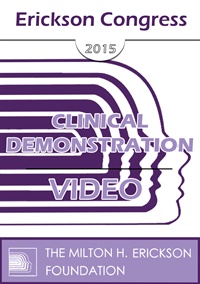
- Average Rating:
- Not yet rated
- Topic Areas:
- Clinical Demonstrations | Hypnosis | Experiential Therapy
- Categories:
- Erickson Congress | Erickson Congress 2015
- Faculty:
- Michael Yapko, PhD
- Course Levels:
- Master Degree or Higher in Health-Related Field
- Duration:
- 01:05:00
- Format:
- Audio and Video
- Original Program Date:
- Dec 11, 2015
- Short Description:
- In this demonstration, hypnosis is used as a framework for self-discovery and boundary setting during a major life transition. A client learns to redirect focus inward, releasing old caretaker patterns and cultivating self-respect and detachment. Through metaphor and experiential guidance, the session illustrates how hypnotic awareness can clarify values, foster emotional independence, and transform empathy from self-sacrifice into balanced, self-sustaining care.
- Price:
-
Sale is $29.00
price reduced from Base Price - $59.00
- Average Rating:
- Not yet rated
- Topic Areas:
- Workshops | Obsessive Compulsive Disorder (OCD)
- Categories:
- Brief Therapy Conference | Brief Therapy Conference 2012
- Faculty:
- Reid Wilson, PhD
- Course Levels:
- Master Degree or Higher in Health-Related Field
- Duration:
- 2:45:17
- Format:
- Audio and Video
- Original Program Date:
- Dec 08, 2012
- Short Description:
- Reid Wilson presents a persuasive, hands-on approach to treating OCD, focusing on modifying belief systems before exposure therapy. He emphasizes frequent, intense ERP practices and creative strategies to disrupt compulsions. Techniques include reframing obsessions, externalizing OCD, using self-commands, and incorporating games, rewards, and routine changes. Case examples range from teens with cleaning rituals to adults with severe compulsions. The session highlights the importance of individualized treatment and parental involvement for long-term success.
- Price:
-
Sale is $29.00
price reduced from Base Price - $59.00
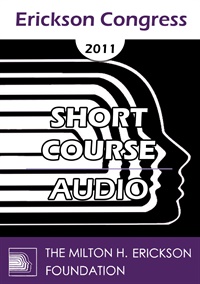
- Average Rating:
- Not yet rated
- Topic Areas:
- Short Courses | Goals of the Therapist | Hypnosis | Post-Hypnotic Suggestion | Suggestion
- Categories:
- Erickson Congress | Erickson Congress 2011
- Faculty:
- Jose Cava Roda, Lic. Psychologist | José Cava, Lic Psychologist
- Duration:
- 1:34:42
- Format:
- Audio Only
- Original Program Date:
- Dec 09, 2011
- Short Description:
- The probability that posthypnotic suggestions will be carried out is highly increased by associating them to the client’s daily life events or activities with an analogical or metaphorical relationship to the therapeutic goals. These life events or activities work as a frequently available signal that facilitates the in-tended behavior or response.
- Price:
- $15.00 - Base Price
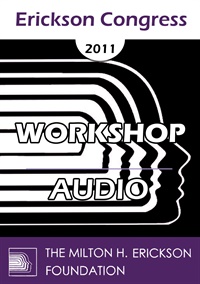
- Average Rating:
- Not yet rated
- Topic Areas:
- Workshops | Obsessive Compulsive Disorder (OCD) | Art and Creativity | Therapist Development
- Categories:
- Erickson Congress | Erickson Congress 2011
- Faculty:
- Reid Wilson, PhD
- Duration:
- 59 Minutes
- Format:
- Audio Only
- Original Program Date:
- Dec 07, 2011
- Short Description:
- A fresh take on treating OCD through strategic persuasion and rapid mindset shifts. This session outlines a protocol of frequent, high-intensity exposures designed to help clients seek out uncertainty and reframe distress. Case studies highlight techniques like degrading rituals, adding consequences, and using practical tools to disrupt compulsive patterns. Emphasis is placed on self-efficacy, belief change, and collaboration for lasting progress — backed by promising pilot study results.
- Price:
- $20.00 - Base Price
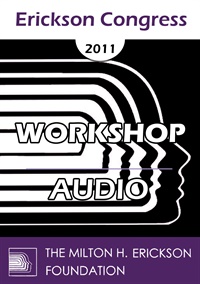
- Average Rating:
- Not yet rated
- Topic Areas:
- Workshops | Ericksonian Hypnosis and Therapy Techniques | Hypnosis | Psychotherapy | Suggestion
- Categories:
- Erickson Congress | Erickson Congress 2011
- Faculty:
- Dan Short, PhD
- Duration:
- 59 Minutes
- Format:
- Audio Only
- Original Program Date:
- Dec 07, 2011
- Short Description:
- The conceptualization of “permissive suggestion” ranks among the most important contributions made by Milton Erickson to hypnosis and psychotherapy. Permissive suggestion is a technique that forms a bridge between a full spectrum of hypnotic procedures and the type of processing needed to address existential dilemmas commonly dealt with in psychotherapy.
- Price:
- $20.00 - Base Price
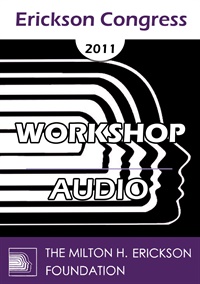
- Average Rating:
- Not yet rated
- Topic Areas:
- Workshops | Hypnosis | Language of Hypnosis | Metaphors | Suggestion
- Categories:
- Erickson Congress | Erickson Congress 2011
- Faculty:
- Norma Barretta, PhD
- Duration:
- 59 Minutes
- Format:
- Audio Only
- Original Program Date:
- Dec 07, 2011
- Short Description:
- Words are the tools of hypnosis. The English language, full of ambiguity, offers remarkable opportunities to embed therapeutic healing messages into the induction and into the body of the hypnotic session. This workshop offers examples and demonstration of multiple meaning and the creative incorporation of linguistic metaphor into therapeutic uses of hypnosis.
- Price:
- $20.00 - Base Price
- Average Rating:
- Not yet rated
- Topic Areas:
- Clinical Demonstrations | Hypnosis | Resources | Pain and Healing | Strengths-Based
- Bundle(s):
- Learning Track - Using Hypnosis
- Categories:
- Brief Therapy Conference | Brief Therapy Conference 2010
- Faculty:
- Michael Yapko, PhD
- Course Levels:
- Master Degree or Higher in Health-Related Field
- Duration:
- 1:00:54
- Format:
- Audio and Video
- Original Program Date:
- Dec 11, 2010
- Short Description:
- This session illustrates how hypnosis can amplify what is already strong in clients, helping them discover and consolidate inner resources that support well-being. By emphasizing curiosity, resilience, and personal strengths, the process demonstrates how shifting focus away from deficits opens pathways to empowerment. Participants gain insight into how hypnosis fosters clarity, confidence, and the ability to navigate challenges with greater ease.
- Price:
-
Sale is $29.00
price reduced from Base Price - $59.00
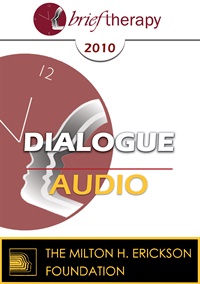
- Average Rating:
- Not yet rated
- Topic Areas:
- Dialogues | Goals of the Therapist | Behavioral Therapy
- Categories:
- Brief Therapy Conference | Brief Therapy Conference 2010
- Faculty:
- Michael Yapko, PhD | James Prochaska, PhD
- Duration:
- 1:00:38
- Format:
- Audio Only
- Original Program Date:
- Dec 11, 2010
- Short Description:
- This dialogue weaves together clinical stories and research to explore how clients can sustain change and prevent relapse. Examples range from smoking cessation in the Air Force to adolescents learning coping skills for stress, showing how readiness, expectancy, and experiential methods influence outcomes. Hear how hypnosis, mindfulness, and feedback can strengthen self-regulation, while goal-setting frameworks help clients progress through stages of change and avoid relapse.
- Price:
- $15.00 - Base Price
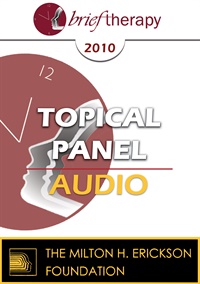
- Average Rating:
- Not yet rated
- Topic Areas:
- Topical Panels | Brief Therapy | Psychotherapy
- Categories:
- Brief Therapy Conference | Brief Therapy Conference 2010
- Faculty:
- Steve Andreas, MA, NLP | Sue Johnson, EdD | Michael Yapko, PhD
- Duration:
- 57:19
- Format:
- Audio Only
- Original Program Date:
- Dec 11, 2010
- Short Description:
- This topical panel explores what actually drives change in brief therapy, drawing from experiential work, attachment theory, cognitive approaches, and social psychology. Through lively debate and clinical examples, it examines speed of change, emotional engagement, therapeutic safety, and the therapist’s role in shaping outcomes, while questioning assumptions about technique, goals, and what truly helps clients move forward.
- Price:
- $15.00 - Base Price
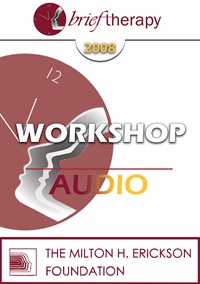
- Average Rating:
- Not yet rated
- Topic Areas:
- Workshops | Hypnosis | Psychotherapy
- Categories:
- Brief Therapy Conference | Brief Therapy Conference 2008
- Faculty:
- Michael Yapko, PhD
- Duration:
- 2:32:58
- Format:
- Audio Only
- Original Program Date:
- Dec 14, 2008
- Short Description:
- This session explores hypnosis as both a subject of modern neuroscience and a practical tool in psychotherapy. Emphasizing dissociation, selective attention, and suggestion, it highlights how hypnosis deepens cognitive and experiential shifts across contexts such as pain management, depression, and memory work. Participants gain a framework for integrating formal and informal hypnosis into their practice, using it not as a therapy in itself but as a powerful way to deliver ideas, evoke resources, and strengthen therapeutic outcomes .
- Price:
- $15.00 - Base Price
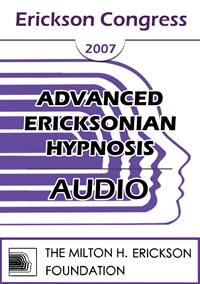
- Average Rating:
- Not yet rated
- Topic Areas:
- Workshops | Confusion Technique | Hypnosis | Indirection | Language of Hypnosis | Binds | Suggestion
- Categories:
- Erickson Congress | Erickson Congress 2007
- Faculty:
- Stephen Lankton, MSW
- Duration:
- 2:50:39
- Format:
- Audio Only
- Original Program Date:
- Dec 10, 2007
- Short Description:
- Participants will be guided through several exercises to help them learn and practice the construction of four forms of confusion technique, bring the number of indirect suggestion to six and the number of therapeutic binds to four. A demonstration using these forms will illustrate the implementations of this set of language techniques for the induction and treatment process.
- Price:
- $15.00 - Base Price
- Average Rating:
- Not yet rated
- Topic Areas:
- Fundamentals of Hypnosis | Hypnosis | Yes Set | Truisms | Suggestion
- Categories:
- Erickson Congress | Erickson Congress 2007
- Faculty:
- Brent Geary, PhD
- Course Levels:
- Master Degree or Higher in Health-Related Field
- Duration:
- 1:42:47
- Format:
- Audio and Video
- Original Program Date:
- Dec 07, 2007
- Short Description:
- It is important to respectfully facilitate a patient's naturalistic elicitation of hypnosis through a rhythmic, absorbing process. This workshop presents "truisms," suggestions, and the "yes set" as just such a way to elicit hypnosis for a variety of applications.
- Price:
-
Sale is $29.00
price reduced from Base Price - $59.00
- Average Rating:
- Not yet rated
- Topic Areas:
- Fundamentals of Hypnosis | Hypnosis | Suggestion | Ericksonian Hypnosis and Therapy Techniques
- Categories:
- Erickson Congress | Erickson Congress 2007
- Faculty:
- Dan Short, PhD
- Course Levels:
- Master Degree or Higher in Health-Related Field
- Duration:
- 1:27:36
- Format:
- Audio and Video
- Original Program Date:
- Dec 07, 2007
- Short Description:
- The conceptualization of “permissive suggestion” ranks among the most important contributions made by Milton Erickson to hypnosis and psychotherapy. Permissive suggestion is a technique that forms a bridge between a full spectrum of hypnot- ic procedures and the type of process needed to address existential dilemmas commonly dealt with in psychotherapy.
- Price:
-
Sale is $29.00
price reduced from Base Price - $59.00
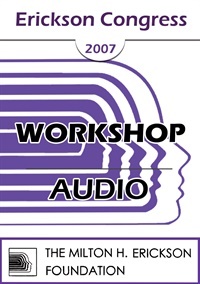
IC07 Workshop 26 - Indirect Suggestions & Therapeutic Binds in Hypnosis - Stephen Lankton, MSW, DAHB
- Average Rating:
- Not yet rated
- Topic Areas:
- Workshops | Ericksonian Hypnosis and Therapy Techniques | Hypnosis | Binds | Indirection | Language of Hypnosis | Suggestion
- Categories:
- Erickson Congress | Erickson Congress 2007
- Faculty:
- Stephen Lankton, MSW
- Duration:
- 1:53:33
- Format:
- Audio Only
- Original Program Date:
- Dec 07, 2007
- Short Description:
- This technique is among the most crucial to good therapy. Participants will be guided through several exercises to help them learn and practice the construction of six forms of indirect suggestions and four forms of binds. A demonstration using these forms will illustrate the implementation of this set of language techniques for the induction and treatment process. The use of indirect suggestions in further treatment will be outlined.
- Price:
- $15.00 - Base Price
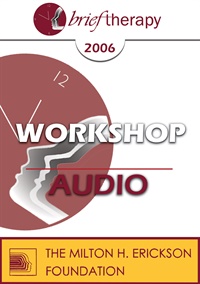
- Average Rating:
- Not yet rated
- Topic Areas:
- Workshops | Cognitive Behavior Therapy (CBT) | Hypnosis
- Categories:
- Brief Therapy Conference | Brief Therapy Conference 2006
- Faculty:
- Michael Yapko, PhD
- Duration:
- 2:39:09
- Format:
- Audio Only
- Original Program Date:
- Dec 10, 2006
- Short Description:
- This session explores how hypnosis enhances cognitive-behavioral therapy by amplifying focus, fostering cognitive flexibility, and reshaping automatic thoughts. Emphasizing experiential learning, the workshop highlights hypnosis as a tool for seeding behavioral activation, building positive expectancy, and helping clients reframe rigid beliefs. Participants gain both a structural model of hypnotic sessions and practical examples of applying hypnosis to depression, anxiety, pain management, and end-of-life care.
- Price:
- $15.00 - Base Price
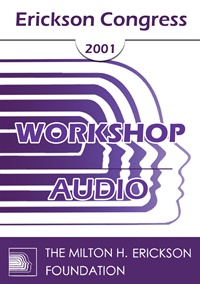
- Average Rating:
- Not yet rated
- Topic Areas:
- Workshops | Metaphors | Confusion Technique | Indirection | Binds | Suggestion
- Categories:
- Erickson Congress 2001 | Erickson Congress
- Faculty:
- Stephen Lankton, MSW
- Duration:
- 2:30:40
- Format:
- Audio Only
- Original Program Date:
- Dec 07, 2001
- Short Description:
- Participants will be guided through several exercises to help them learn and practice the construction of six forms of indirect suggestions, four therapeutic binds and four verbal confusion techniques. A demonstration using these forms will illustrate the implementation of this set of language techniques for the induction process and how they elaborate simple metaphor. Reasons for the use of indirect suggestions, binds and confusion in treatment and their effect will be addressed and demonstrated.
- Price:
- $15.00 - Base Price
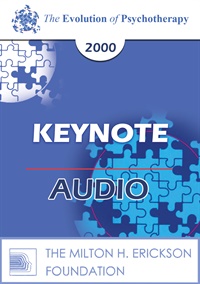
- Average Rating:
- Not yet rated
- Topic Areas:
- Keynotes | Social Psychology | Research | Communication | Motivation
- Categories:
- Evolution of Psychotherapy | Evolution of Psychotherapy 2000
- Faculty:
- Elliot Aronson, Ph.D.
- Duration:
- 1 Hour 3 Minutes
- Format:
- Audio Only
- Original Program Date:
- May 28, 2000
- Short Description:
- This talk brings social psychology to life through vivid, often surprising stories about how people talk themselves into change. Rather than relying on advice or persuasion, it shows how situations that evoke integrity, empathy, and personal responsibility can lead to lasting shifts in behavior. Therapists and students will find fresh ways to think about motivation, resistance, and change, with ideas that naturally echo many therapeutic moments in the consulting room.
- Price:
- $15.00 - Base Price
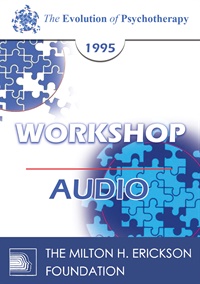
- Average Rating:
- Not yet rated
- Topic Areas:
- Workshops | Psychotherapy | Therapist Development | Systems Theory | Intervention Strategies
- Categories:
- Evolution of Psychotherapy | Evolution of Psychotherapy 1995 | Pioneers in Couples and Family Therapy
- Faculty:
- Paul Watzlawick, PhD
- Duration:
- 2 Hours 36 Minutes
- Format:
- Audio Only
- Original Program Date:
- Dec 13, 1995
- Short Description:
- This workshop explores how rigid, self-reinforcing behavioral patterns—“games without end”—can be disrupted through meta-level interventions. Drawing on Bateson’s systems theory and Erickson’s clinical methods, the discussion covers strategies like benevolent sabotage, paradox, and behavior prescriptions that shift entrenched dynamics. Practical examples include work with perfectionism, sexual disconnection, and resistant teens. The role of language, suggestion, and therapeutic relationship are central themes throughout.
- Price:
- $15.00 - Base Price
Tags: Paradoxical Interventions Strategic Use of Language Symptom Prescription Therapist Flexibility Utilization Rapid Intervention Adolescents Behavioral Prescriptions Ericksonian Hypnosis and Therapy Techniques Gregory Bateson Perfectionism Resistance Sex and Sexuality Suggestion Therapeutic Relationship
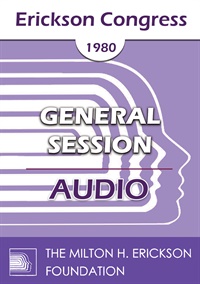
- Average Rating:
- Not yet rated
- Topic Areas:
- General Sessions | Psychotherapy | Hypnosis | Neuroscience | Research
- Categories:
- Erickson Congress | Erickson Congress 1980
- Faculty:
- David Akstein, MD | Lars-Eric Unestahl, PhD | Michal Vancura | Leonard J Ravitz, MD
- Duration:
- 3:01:25
- Format:
- Audio Only
- Original Program Date:
- Dec 06, 1980
- Short Description:
- This wide-ranging session traces the evolution of hypnotic theory and practice across Eastern Europe, from Pavlovian “partial sleep” models to more contemporary, active, and permissive approaches. Presenters review research on induction methods, ideomotor action, posthypnotic signaling, and spontaneous trance, along with cross-cultural clinical innovations in medicine, psychotherapy, and child treatment. Participants gain a rare historical and scientific overview of how hypnosis has been studied, taught, and applied in Czechoslovakia, the Soviet Union, East Germany, Poland, Hungary, and beyond.
- Price:
- $15.00 - Base Price



